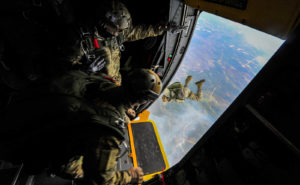
The U.S. relies on the domestic industrial base to meet military needs.
In enacting the Defense Production Act of 1950, Congress listed eight findings to support its “statement of policy.” The last one states that “the inability of industries in the United States, especially smaller subcontractors and suppliers, to provide vital parts and components and other materials would impair the ability to sustain the Armed Forces of the United States in combat for longer than a short period.”
The act further says, “Every effort should be made to foster cooperation between the defense and commercial sectors for research and development and for acquisition of materials, components, and equipment.”
A Congressional Research Service report in July 2014 noted that Congress has expanded “national defense” to include activities related to homeland security and domestic emergency management.
Since 2011, Nanocomp Technologies Inc. of Merrimack, N.H., has been working with the U.S. government under the Defense Production Act (DPA) Title III, a program designed to address shortfalls in industrial capacity to meet national defense needs.
“Nanocomp has had a long history of working with end-user government agencies, major defense prime contractors and system integrators that supply subsystems in the supply chain,” says John Dorr, vice president of business development. The Title III project involves volume production of the company’s carbon nanotube (CNT) yarn, sheet and tape materials for land, sea, air and space applications. Among the successful benchmarks, CNT shielding was used on NASA’s Juno spacecraft and data cables achieved a 69 percent weight reduction.
It becomes very important to understand what the government’s needs are and then to strike up relationships to show you have a good, mature solution when the government puts out the call for bids. – John Cronin, HP White Laboratory Inc.
In 2012, Nanocomp more than doubled its facility size, from 11,000 to 30,000 square feet. In 2014, the company tripled its manufacturing capacity, made possible by an $18.5 million contract from the Department of Defense (DOD).
“The Title III mission is to capitalize the manufacturing infrastructure of businesses that provide product technology deemed critical to U.S. national defense where it has been determined that national demand is significantly higher than capacity,” Dorr says. “Although the process of product qualification and program procurement remains the same as with any other product or technology, an assured supply reduces the risks a program manager faces when adopting a new technology.” He points out that Nanocomp is free to offer its products to commercial markets as well.
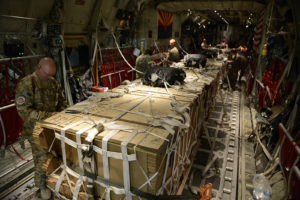
What they want
“A key concept in DOD circles is reduced SWAP: size, weight and power,” Dorr says. “Any technology that offers a cost-effective path contributing to this goal is of great interest to our military clients. Although budgets are under severe pressure, significant investments are being made in technology that addresses the SWAP objective.”
“From a design perspective, it’s all about optimized ease of use, rapid deployment or strike capability, and understanding the accommodations required in terms of climate, load and functionality. From a performance perspective, the focus is on optimizing energy efficiency, durability, portability and ease of maintenance,” says Andy Hove, president and CEO of HDT Global. HDT designs, engineers and manufactures military expeditionary systems, including a variety of shelters and accessories. Recent additions to the Solon, Ohio-based company’s product line are a shelter liner that shields computers from electromagnetic interference and cold-weather shelters using dual layer, weatherproof, breathable fabric construction with ample ventilation to prevent moisture and condensation buildup on interior surfaces.
“Based on the need to maximize every dollar spent, military customers focus on energy efficiency, reduced fuel consumption and maximum return on investment,” Hove says.
Polo Custom Products’ custom-sewn products include harnesses, holsters, gun covers for Navy ships and sound blankets for Army vehicles.

“We work with engineers in product development to enhance or improve existing products or they come to us with a concept and we use CAD technology to create something virtual to build the actual product, create a bill of materials and make drawings to take the design into production,” says Wayne Hiegert, vice president of sales and marketing for the Topeka, Kan.-based company. One of Polo’s newest products is a patient wrap that protects soldiers in biological weapons settings.
The demand for continually better military products “constantly pushes us to be aware of what’s out there and what our suppliers are working on for procurement,” Hiegert says. “We have our procurement personnel and engineers attend seminars to see what’s coming out in terms of technology.”
In 1952—six years into business—Gehring-Tricot Corp. established its Militex division to support the military market. The Dolgeville, N.Y.-based manufacturer of knits and stretch-woven fabrics has been active in solving apparel and insect netting needs. Among its activities in the defense market, Gehring-Tricot has participated in writing military specs for warp knit meshes for vests, introduced textile cooling system technology via spacer fabrics for tactical vests and partnered in textile composite solutions for tank protection.
According to Bill Christmann, vice president of sales and marketing, Gehring-Tricot’s military clients seek multifunctionality.
“The more results that can be drawn from less bulk to carry and transport, the better,” he says. “For example, if something can be thermally protective, offer padding and odor control, and be lightweight, it may replace multiple items.”
“Priorities are determined by a number of factors, especially the threats being encountered and those that are anticipated in the future,” says Eugene Wilusz, senior chemical biological defense scientist at the U.S. Army Natick Soldier Research, Development and Engineering Center in Natick, Mass. “Lightweight ballistic and blast protection and low-cost flame resistance are priorities. Improved uniforms for jungle and arctic environments, as well as advanced textile treatments for protection from insect bites, are being researched. Other areas of interest include intelligent textiles for power generation using flexible solar panels and energy harvesting from body movements.”
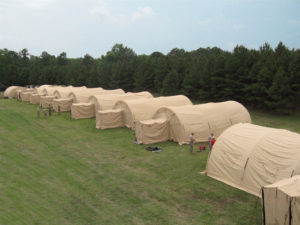
Overcoming hurdles
“Our 3-D woven materials are finding interest in a number of military applications where damage tolerance and/or delamination resistance are important to the success of a composite component,” says Steve Clarke, president of t.e.a.m. Inc. in Woonsocket, R.I. His company’s products—used, for example, in military aircraft engines, vehicle armor, outer skins and leading edges of aeroshell structures—improve performance, save weight and cost less compared to metals.
But the need for the best materials available in national defense applications is paired with federal budget constraints. A 2014 article in National Defense magazine reported that funding for the Defense Advanced Research Projects Agency’s (DARPA) Soldier Protection Systems project to equip troops with lighter, more functional gear was dropping from $22.9 million to $7.5 million in 2015. Manufacturers told the magazine that research programs did not generate enough work to sustain a manufacturing plant.
“The Army vehicle market has been fraught with starts and stops, sequestration and budget cuts,” Clarke says. “It’s very difficult to develop new technology, mature it and then get it fielded. Military clients want the damage tolerance that 3-D woven structures can provide, but they also want to save money and not give up performance.”
HDT likewise sees a low cost/high performance hurdle in the military arena.
“HDT works hard demonstrating the quality and efficiency of our solutions,” Hove says. “The value proposition carries even more significance when budgets are tight and the military is looking for solutions that will perform in harsh environmental conditions. Our field-based support teams regularly train military personnel on proper operating and maintenance procedures for [our products].
“HDT invests significantly in research and development,” he adds. “Our engineering staff works closely with military customers to understand their needs.”
Christmann notes a dearth of domestic mills with the financial and technical ability to support the innovation and development necessary to support national defense needs.
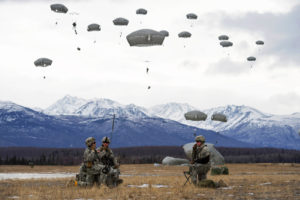
“This challenges everyone’s ability to support low cost, quick turnaround and manageable minimum-order quantities,” he says. “That said, those that can best meet these necessities are most likely to participate in the military market.”
Putting it all together
John Cronin, president of HP White Laboratory Inc. in Street, Md., says that his company’s testing of raw materials and finished “head-to-toe” soldier equipment has evolved based on the federal government’s procurement model. He refers to DARPA’s Soldier Protection System as an example of how times have changed.
“The government in the past would procure a single piece of equipment. Today it’s all integrated into one system,” Cronin says. “The challenge you have with that type of procurement is they’re going to prime contractors, who are pulling together all the subcontractors. All the different components have to come together at the same time. You come with a proposal for a fully integrated system.”
A helmet, for example, is more than just the shell. It is viewed in conjunction with other components, such as a visor, mandible guard and power generation.
“In the old days you only had to worry about your own individual component. Now you have to make sure other companies have their testing data within the bid proposal. This is where relationships in the industry are so important. If you make a helmet, you have good relationships with textile manufacturers, resin manufacturers and mold makers. You may not have relationships with battery manufacturers,” he adds.
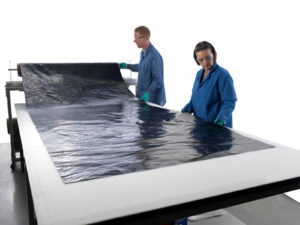
“It becomes very important to understand what the government’s needs are and then to strike up relationships to show you have a good, mature solution when the government puts out the call for bids.”
Cronin suggests that manufacturers attend the government’s Industry Days.
“They will tell you what their procurement objectives are,” he says. “It’s a great place to meet people and see who’s engaging in the process.”
In April, the DOD issued Better Buying Power 3.0, the latest iteration of the initiative launched in 2010 to achieve greater efficiencies in procurement while encouraging productivity and innovation.
“The United States remains the world’s leader in military innovation, and research investments remain high for technology advancements,” Dorr says. “Better Buying Power 3.0, with its focus on maintaining the U.S. technology edge, should help companies like Nanocomp penetrate military applications.”
Janice Kleinschmidt is a freelance writer based in San Diego, Calif.
In July, Industrial Fabrics Association International (IFAI) president Mary Hennessy announced an initiative to create a searchable database for the Department of Defense (DOD) to identify industrial fabrics companies and products under the Military Uniform System Technology (MUST) program funded by the Defense Logistics Agency (DLA).
Maureen MacGillivray, professor of apparel merchandising and design at Central Michigan University who won the award for the program from the Department of Defense, and Robert Bona, CEO of AdvanTech Inc. of Annapolis, Md., are working on the programming and administration of this project for IFAI’s Military Division. In August, IFAI presented a webinar on the topic; at IFAI Expo 2015 in October, MacGillivray, her CMU colleague Tanya Domina, and Bona gave a demonstration on the MUST portal.
“The project focuses on improving collaboration between military and commercial manufacturers through the development of an Internet-based knowledge base that contains fabric specifications and properties available for purchase by the DLA or military services,” MacGillivray says. “Fabric manufacturers are submitting their spec sheets. Textile testers are submitting testing results and end product manufacturers are submitting product information.”
Aimed in part at streamlining the supply chain effort associated with developing and implementing new requirements for items, the initiative will be evaluated over the next several months.

“Scorpion” is rolled out
The rollout of the Army’s new camouflage pattern (called Scorpion W2) began in September, with the goal to have every soldier wearing the improved design by October 2019. Packs, pouches and other equipment also are affected by the change.
“The biggest thing when they change a pattern or material is that you are faced with a large minimum order; and if you don’t have large solicitations to consume that, then it makes it difficult to do R & D work,” says Wayne Hiegert of Polo Custom Products, which uses camouflage fabric for its holster and patient wrap.
“Sometimes you are limited on what you can get in a new camouflage pattern, and if you are doing the R & D work to show the government a better product, you have to decide whether you want to make that investment in R & D,” he says.
 TEXTILES.ORG
TEXTILES.ORG


